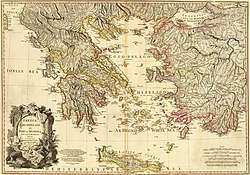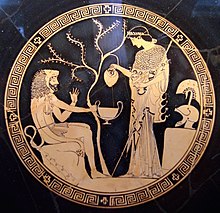Dorian invasion
| History of Greece |
|---|
 |
|
|
The Dorian invasion is a concept devised by historians of Ancient Greece to explain the replacement of pre-classical dialects and traditions in southern Greece by the ones that prevailed in Classical Greece. The latter were named "Dorian" by the ancient Greek writers, after the Dorians, the historical population that spoke them.
Greek legend asserts that the Dorians took possession of the Peloponnesus in an event called the Return of the Heracleidae (Ancient Greek: Ἐπιστροφὴ τῶν Ἡρακλειδῶν). Nineteenth-century Classical scholars saw in the legend a possibly real event they termed the Dorian invasion. The meaning of the concept has changed several times, as historians, philologists and archaeologists used it in attempts to explain the cultural discontinuities expressed in the data of their fields. The pattern of arrival of Dorian culture on certain islands in the Mediterranean, such as Crete, is also not well understood. The Dorians colonised a number of sites on Crete such as Lato.[1]
Despite nearly 200 years of investigation, the historicity of a mass migration of Dorians into Greece has never been established, and the origin of the Dorians remains unknown. Firm archeological evidence of such an invasion has not been established. Nonetheless, the pervasiveness of the Dorians in literature means that most historians do not reject the theory.[2] Some have linked them or their victims with the emergence of the equally mysterious Sea Peoples during the Late Bronze Age collapse. The meaning of the phrase "Dorian invasion" as an explanation for the cultural and economic breakdown after the Mycenaean period and into the Greek Dark Ages has become to some degree amorphous.
Return of the Heracleidae[]

Classical tradition, as recorded for example in Herodotus, describes the "Return of the Heracleidae" (Ἐπιστροφὴ τῶν Ἡρακλειδῶν), the descendants of Heracles, who were exiled at his death and returned in later generations to reclaim the dominion that Heracles had held in the Peloponnesus. The Greece to which the tradition refers is the mythic one, now considered to be Mycenaean Greece. The details differ from one ancient author to another, the commonality being that a traditional ruling clan traced its legitimacy to Heracles.
The Greek words referring to the influx of the Dorians are katienai[3] and katerchesthai, literally "to descend", "come down" or "go down" or, less commonly, "be brought down." It means a descent from uplands to lowlands, or from earth to grave, or rushing down as a flood, or sweeping down as a wind, or those who have returned from exile by ship. This sweeping down upon the Peloponnesus invited the English translation "invasion".
There is, however, a distinction between Heracleidae and Dorians. George Grote summarizes the relationship as follows:[4]
Herakles himself had rendered inestimable aid to the Dorian king Aegimius, when the latter was hard pressed in a contest with the Lapithae .... Herakles defeated the Lapithae and slew their king Koronus; in return for which Aegimius assigned to his deliverers one third part of his whole territory and adopted Hyllus as his son.
Hyllus, a Perseid, was driven from the state of Mycenae into exile after the death of Heracles by a dynastic rival, Eurystheus, another Perseid:[5]
After the death ... of Herakles, his son Hyllos and his other children were expelled and persecuted by Eurystheus ... Eurystheus invaded Attica, but perished in the attempt .... All the sons of Eurystheus lost their lives ... with him, so that the Perseid family was now represented only by the Herakleids ....
The Pelopid family now assumed power. The Heraclids "endeavored to recover the possessions from which they had been expelled" but were defeated by the Ionians at the Isthmus of Corinth. Hyllus staked peace for three generations against immediate reoccupation on a single combat and was killed by Echemus of Arcadia.
The Heracleidae now found it prudent to claim the Dorian land granted to Heracles:[4] "and from this moment the Herakleids and Dorians became intimately united together into one social communion." Three generations later the Heracleidae with Dorian collusion occupied the Peloponnesus, an event Grote terms a "victorious invasion."[5]
The term "invasion"[]
The first widespread use of the term "Dorian invasion" appears to date to the 1830s. A popular alternative was the "Dorian migration". For example, in 1831 Thomas Keightly was using "Dorian migration" in Outline of History; by 1838 in The Mythology of Ancient Greece and Italy he was using "Dorian invasion".
Neither of those two words exactly fits the events, as they imply an incursion from outside a society to within; but the Dorians were not outside of either Greece or Greek society. William Mitford's History of Greece (1784–1810)[6] described a "Dorian conquest" followed by "a revolution in Peloponnesus so complete that, except in the rugged province of Arcadia, nothing remained unaltered."[7]
In 1824 Karl Otfried Müller's Die Dorier was published in German and was translated into English by Tufnel and Lewis for publication in 1830. They use such terms as "the Doric invasion"[8] and "the invasion of the Dorians"[9] to translate Müller's "Die Einwanderung von den Doriern" (literally: "the migration of the Dorians"),[10] which was quite a different concept.
On one level the Einwanderung meant no more than the Heraklidenzug, the return of the Heracleidae. However, Müller was also applying the sense of Völkerwanderung to it, which was being used of the Germanic migrations. Müller's approach was philological. In trying to explain the distribution of tribes and dialects he hypothesized that the aboriginal or Pelasgian population was Hellenic. His first paragraph of the Introduction asserts:[11]
The Dorians derived their origin [der Ursprung des dorischen Stammes] from those districts in which the Grecian nation bordered toward the north upon numerous and dissimilar races of barbarians. As to the tribes which dwelt beyond these borders we are indeed wholly destitute of information; nor is there the slightest trace of any memorial or tradition that the Greeks originally came from those quarters.
Müller goes on to propose that the original Pelasgian language was the common ancestor of Greek and Latin,[12] that it evolved into Proto-Greek and was corrupted in Macedon and Thessaly by invasions of Illyrians. This same pressure of Illyrians drove forth Greeks speaking Achaean (including Aeolian), Ionian, and finally Dorian in three diachronic waves, explaining the dialect distribution of Greek in classical times.[13]
Following this traditional view, the linguist noticed that in the Peloponnesus and in the islands, where the Dorians established themselves, their dialect showed elements of the Arcadian dialect. This can be explained if the Dorians conquered a Pre-Doric population, which was pushed into the Arcadian mountains. Where the Dorians were a minority, there is a mixed dialect, as in Boeotia, or the Dorians adopted the existing dialect, as in Thessaly.[14] To the Achaeans described by Homer belongs the Aeolic-Arcadian dialect in the whole of eastern Greece, with the exception of Attica, where the Ionians were confined. The Ionians must be considered the oldest first wave of the Greek migration.[15]
In 1902, K. Paparigopoulos, calling the event the "Descent of the Heraclidae", stated that the Heraclidae came from Thessaly after being expelled by the Thessalians living in Epirus.[16]
Kretschmer's external Greeks[]
Toward the end of the 19th century the philologist Paul Kretschmer made a strong case that Pelasgian was a pre-Greek substrate, perhaps Anatolian,[17] taking up a classical theme of remnant populations existing in pockets among the Greek speakers, in mountainous and rural Arcadia and in inaccessible coasts of the far south. This view left Müller's proto-Greeks without a homeland, but Kretschmer did not substitute the Heracleidae or their Dorian allies from Macedon and Thessaly. Instead he removed the earliest Greeks to the trail leading from the plains of Asia, where he viewed the Proto-Indo-European language as having broken up about 2500 BC. Kretschmer suggested that somewhere between that Asian homeland and Greece a new cradle of the Greek tribes developed, from which Proto-Ionians at about 2000 BC, Proto-Achaeans at about 1600 BC and Dorians at about 1200 BC came to swoop down on an increasingly less aboriginal Greece as three waves of external Greeks.[18]
Kretschmer was confident that if the unknown homeland of the Greeks was not then known, archaeology would find it. The handbooks of Greek history from then on spoke of Greeks entering Greece. As late as 1956 J.B. Bury's History of Greece (3rd edition) wrote of an "invasion which brought the Greek language into Greece". Over that half-century Greek and Balkan archaeology united in an effort to locate the Dorians further north than Greece. The idea was combined with a view that the Sea Peoples were part of the same north-south migration about 1200 BC.
The weakness in this theory[19] is that it requires both an invaded Greece and an external area where Greek evolved and continued to evolve into dialects contemporaneously with the invaded Greece. However, although the invaded Greece was amply represented by evidence of all sorts, there was no evidence at all of the external homeland. Similarly, a clear Greek homeland for the Sea Peoples failed to materialize. Retaining Müller's three waves and Kretschmer's Pelasgian pockets the scholars continued to search for the Dorians in other quarters. Müller's common ancestor of Greek and Latin had vanished by 1950; and by 1960, although still given lip service, the concept of Greek developing outside of Greece was in decline.[20]
Greek origin in Greece[]

Additional progress in the search for the Dorian invasion resulted from the decipherment of Linear B inscriptions. The language of the Linear B texts is an early form of Greek now known as Mycenaean Greek. Comparing it with the later Greek dialects scholars could trace the development of the dialects from the earlier Mycenaean. For example, classical Greek anak-s (ἄναξ), "king", was postulated to be derived from a reconstructed form *wanak- (ϝάναξ). In the Linear B texts appears the form
